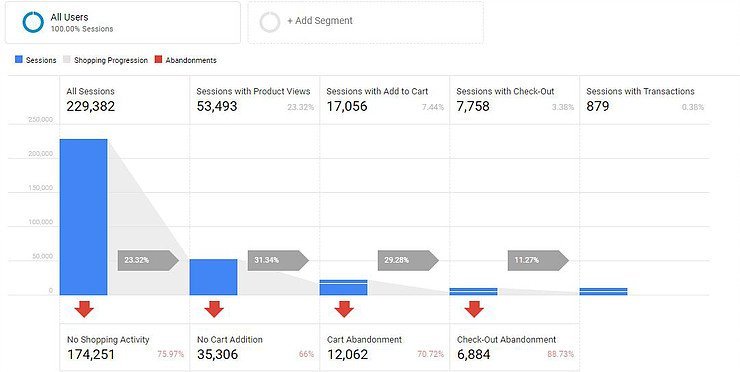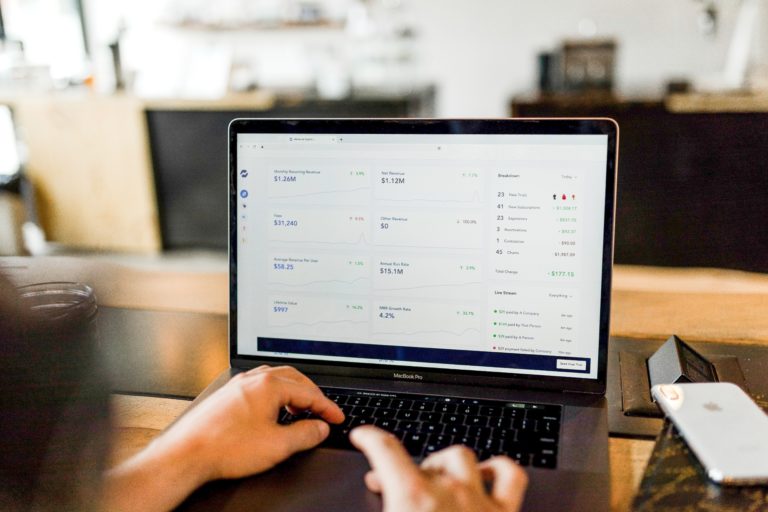Are you an eCommerce business looking to improve your online metrics?
Just like the checkout funnel analysis, conducting a shopping funnel analysis can also be a very effective way of drastically improving a website’s sales/conversions in a short span of time.
The main goal of a shopping funnel analysis is to reduce shopping abandonment as much as possible. Shopping abandonment is when a customer visits your website, initiates some sort of shopping activity but doesn’t complete the checkout for whatever reason. Shopping activities may include:
· Viewing/Clicking an internal promotion
· Looking at a product list
· Clicking on one of the products in a product list
· Looking at a product description
· Adding/Removing products from the shopping cart
· Starting the checkout process
· Redeeming a discount code/voucher
· Making a purchase
· Asking for a refund
If you use Google Analytics, you can conduct a Shopping Funnel Analysis with the following reports:
· Funnel Visualization Report
· Goal Flow Report
· Shopping Behaviour Analysis Report (The best one, in my opinion)

*Please note that the Shopping Behaviour Analysis report is only available if you have Enhanced Ecommerce Tracking active in your Google Analytics.
Stages of a Shopping Funnel
The reason why I prefer the shopping behaviour analysis report over the other ones is because it clearly shows the stages of your website’s shopping funnel and how customers progress from one stage of your funnel to the next. It also shows where customers enter and exit your funnel and which stages have the highest abandonment rates.
1. All Sessions – These are all the sessions that have been counted by Google Analytics within a particular time period.
2. Sessions with product views – These are all the sessions that involved a customer viewing a product page on your website.
3. Sessions with Add to Cart – These are all the sessions that involved customers adding product to their shopping cart.
4. Sessions with Checkout – These are all the sessions that involved a customer starting a checkout process on your website.
5. Sessions with Transactions – These are all the sessions that involved a customer completing a transaction/making a purchase on your website.
Shopping Abandonment
The shopping abandonment rates are shown by the red arrows and percentages underneath each stage of the funnel.
No Shopping Activity – All the sessions counted by GA in which no shopping activity was initiated by the customer.
No Cart Addition – All the sessions whereby customers viewed a product(s) on your website but didn’t add anything to their cart.
Cart Abandonment – All the sessions whereby a customer added a product to their cart but didn’t initiate the checkout process.
Checkout Abandonment – All the sessions whereby a customer initiated the checkout process but didn’t actually complete the purchase.
Possible Causes for Drop-Offs/Abandonment
Use the shopping behaviour analysis report to identify which stages have the biggest drop-offs and start working towards reducing them. Below are some the possible reasons as to why certain stages of the shopping funnel may have a high drop-off rate:
No Shopping Activity – If a high percentage of your shopping abandonments are happening at this stage, it most likely means that the traffic that is coming to your store is low-quality traffic (i.e. people that have little to no interest in what your business has to offer). The best thing to do in this scenario to optimise your marketing campaigns and make sure that they are being targeted towards your most ideal target market.
No Cart Addition – If a high percentage of shopping abandonments are happening at this stage, this means visitors are coming to your website, looking at what your selling, but aren’t being compelled to buy. In other words, your product description pages aren’t doing their job well.
Review your product description pages – Make that aren’t missing any vital information and play to certain positive emotions of your visitors (Pleasure, Relief, Joy, Pride, etc). Also ensure that your product detail pages don’t have any technical errors they may be dissuading people to buy from you.
Cart Abandonment – If a high percentage of shopping abandonments are happening at this stage, it means that a lot of your visitors are coming to your website, seeing a product that they are interested in, adding that product to their cart but for whatever reason… they don’t initiate the checkout process.
The most common reasons for cart abandonment are:
· Better price/offer found elsewhere
· High/Unexpected charges
· Customer adds item to cart with intention of buying but forgets to come back
eCommerce customers rarely buy from a website on their first visit and often compare prices/offers between similar websites before deciding where to make the purchase.
Using various remarketing strategies is a very effective way of recovering lost sales and reminding customers who drop-out at this stage to come back and by from you.
Checkout Abandonment – If a high percentage of shopping abandonments are happening at this stage, it means that a lot of your visitors are coming to your website, seeing a product that they are interested in, adding that product to the cart, starting the checkout process but then for whatever reason… they don’t make the payment and complete the process.
This stage is the most crucial stage of the shopping funnel and should always be the priority of focus. Check out my Using Analytics to reduce Checkout Abandonment article for in-depth instructions on how to reduce your website’s checkout abandonment.





